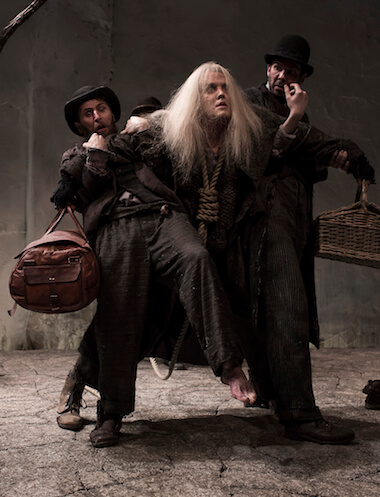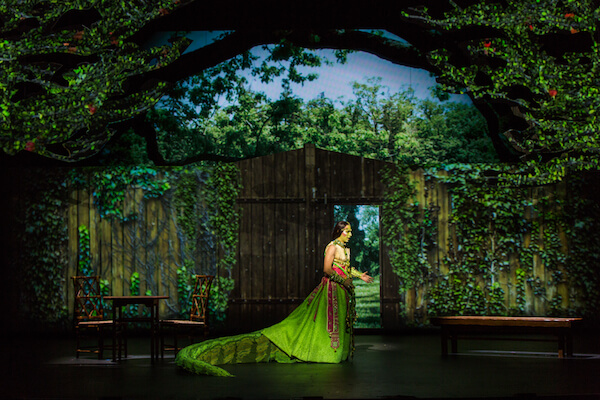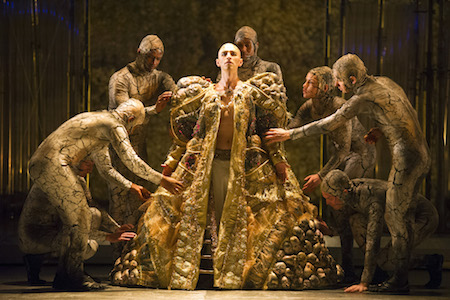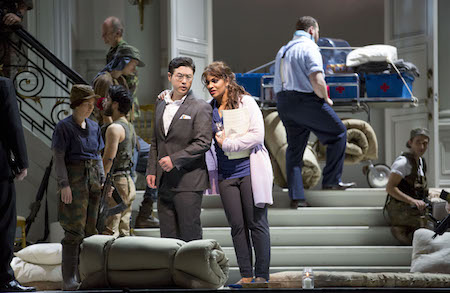Anthony Roth Costanzo in the Glimmerglass production of Pergolesi’s “Stabat Mater.” | KARLI CADEL/ GLIMMERGLASS FESTIVAL
“Der fliegende Höllander” was the Glimmerglass Festival’s first canonical Wagner (his early “Das Liebesverbot” was presented in 2008). August 16’s musical performance under John Keenan succeeded admirably — though the brass section, as in most theaters, had issues. Standard cuts were (admirably) opened in Act Three’s trio, but curiously Francesca Zambello placed the entr’acte after Senta first sees the Dutchman — an interesting effect, but it undermined the tense dramatic pauses Wagner provided.
Three balls, two strikes at Glimmerglass
Francesca Zambello’s production, despite some missteps — too many extras, too much dancing (too much dancing, in fact, permeated the entire season) — made for an exciting evening. The sets had a striking if unbeautiful industrial look, with nautical elements brought in mainly by means of omnipresent rope and rope ladders. In the line of Jean-Pierre Ponnelle’s “Steerman’s Dream” concept, we witnessed “Senta’s dream,” with the girl starting and ending the evening in bed — moving, it seemed, from self-imposed erotic bondage to a (technically improbable) self-garroting as a sacrifice, with a Senta double joining the Dutchman in ascending a rope ladder heavenwards far upstage.
In Melody Moore’s very impassioned and detailed performance, offered in fine, generous lyric sound with keen textual sense, Senta was far more knowing and capricious than usual. In fact, she was sexually aggressive with both Erik and the Dutchman, whose shirt she removed after 20 minutes’ acquaintance. Zambello likes to expose bare male chests; with handsome Ryan McKinny on board no one objected.
McKinny looks to be a fine lyrical Wagner singer in the tradition of Thomas Stewart. As the Dutchman, his volume and projection depended on his set placement; frequently when stuck upstage he sounded contained; from the main playing area, the voice resounded with its full promise. A conscientious stylist, he lacked demonic presence, which may come with experience in the role. This was a very sound start.
Peter Volpe made a lively if predictably growly Daland; Jay Hunter Morris managed Erik’s ungrateful music acceptably, with some ardor.
Zambello has decreed a “classic musical” every year as part of the mix — a sound idea economically and welcome when the shows chosen are of genuine musical interest. Despite two or three fine songs, that does not apply remotely to “Camelot,” with its tedious book and often lamentably banal score. The 1960 show is remembered for its stars (Richard Burton, Julie Andrews, Robert Goulet) and — sentimentally — for reflecting the ersatz glory of Kennedy’s presidency. It’s a dated, depressingly faux-naive show undeserving of attention.
It could only work as a lavish spectacle, but here, though Paul Tazewell’s costumes deserve praise, the mise-en-scène August 17 evoked a cheap provincial touring company. By far the best element was David Pittsinger’s beautifully sung, mellowly spoken Arthur, dashing but with gravitas.
Nathan Gunn looked not much younger than Pittsinger; he handles American art song commendably but his virtues as a Broadway leading man have been oversold. There’s not much imagination on display, and the still-pleasant voice has diminished in freedom. His Lancelot affected — at times — a French accent out of “Monty Python.”
The audience loved Andriana Chuchman’s Guinevere; she sang well and moved gracefully but the charm seemed appliqué except in a wistful “Before I Gaze at You Again.” Wynn Harmon (Merlyn/ Pellinore) gave us a welcome dose of Broadway know-how, and Noel Bouley showed a substantial baritone as Sir Lionel, a role originated by the great Bruce Yarnell.
That evening brought Verdi’s rare early comedy “Un giorno di regno,” given as “King for a Day” in Kelley Rourke’s English version, which combined genuine cleverness and silly doggerel, indiscriminately referencing — as did Christian Räth’s desperate-to-be-funny staging — popular culture of the last six decades. Askew frames, paparazzi, “acting funny” crowding out humor — even a thoroughly pointless Elvis mask at the end. This kind of production, wedded to yuck-filled titling, delights that not inconsiderable portion of the operatic audience who prefer not to listen. I found it pretty excruciating, though it was great to hear the “baby steps away from bel canto” score so fluently conducted by Joseph Colaneri.
Two Young Artists fared very well. Jacqueline Echols (Giulietta, the ingénue) owns a lovely, poised soprano with a distinctive timbre; she alone kept her dignity onstage, acting like a genuine human being among the sub-sitcom antics. Patrick O'Halloran (Edoardo, her suitor) is still growing into his lyric tenor but showed impressive concern with line and phrasing.
The putative stars, posturing wildly, suggested Looks Casting run amok. Alex Lawrence (Belfiore) offered a fine middle register but proved ineffective on low notes; the top often threatened minor cracks. Slim, glamorous Ginger Costa-Jackson (Marchesa) could barely begin to execute her music (no trills, poor runs, unblended registers) and was given unadulterated shtick — a poodle with sunglasses, a drunk scene — to attempt to cover that.
When multiple wedding couples jumped through a frame, some applause broke out after two men made the leap. I would have joined in had the two poor apprentices not been directed to flounce limp-wristedly. Did Räth think the audience would not recognize two men (or women?) as a legitimate couple otherwise? Added to Jack Noseworthy’s epicenely hateful Mordred — a professional job, but still — earlier that day, it made me marvel yet again how much minstrelsy largely gay-run and staffed opera companies continue to promote.
August 18’s double bill “Passions” showed, like the Wagner, what Glimmerglass should always be like and offers at best. It paired the Pergolesi “Stabat Mater” (1736) and David Lang’s 2007 “The Little Match Girl Passion,” a work that tells Hans Christian Andersen’s heart-rending story in Bachian terms, with only sparely accompanied chorus and four vocal soloists.
The Pergolesi was exquisite, thanks, in part, to a lovely scenic concept involving the shifting bars of a cross and some sensitive choreography by director Jessica Lang but, above all, to conductor Speranza Scappucci — who skillfully imposed baroque practice on a non-specialist orchestra — and her graceful, sonorous soloists, Nadine Sierra and the Met’s Anthony Roth Costanzo. The pair sang Orfeo and Eurydice together at Palm Beach Opera in 2011; their stage rapport showed. The countertenor in particular sang with remarkable control, stylistic awareness, and compelling expressiveness. His ravishing solos furnished the summer’s highlight.
The “Stabat mater” is a hard act to follow. Lang’s little minimalist oratorio goes on too long — its entire final movement being cut would make for a more profound and affecting ending — but is quite impressive. Zambello as director and David Moody as conductor got better results with the adults than with the children’s chorus — the boys consistently sang flat.
The soloists, sounding repeated textual fragments and handling instruments, proved able — Lisa Williamson, soaring easily through the passaggio, and arresting-voiced Julia Mintzer, who had the most narration, quite exceptional. This thoughtful pairing of baroque and contemporary music — like the Wagner — was the kind of production people travel to Cooperstown to experience.
Next summer’s best prospect: “Ariadne auf Naxos,” starring Christine Goerke.




































